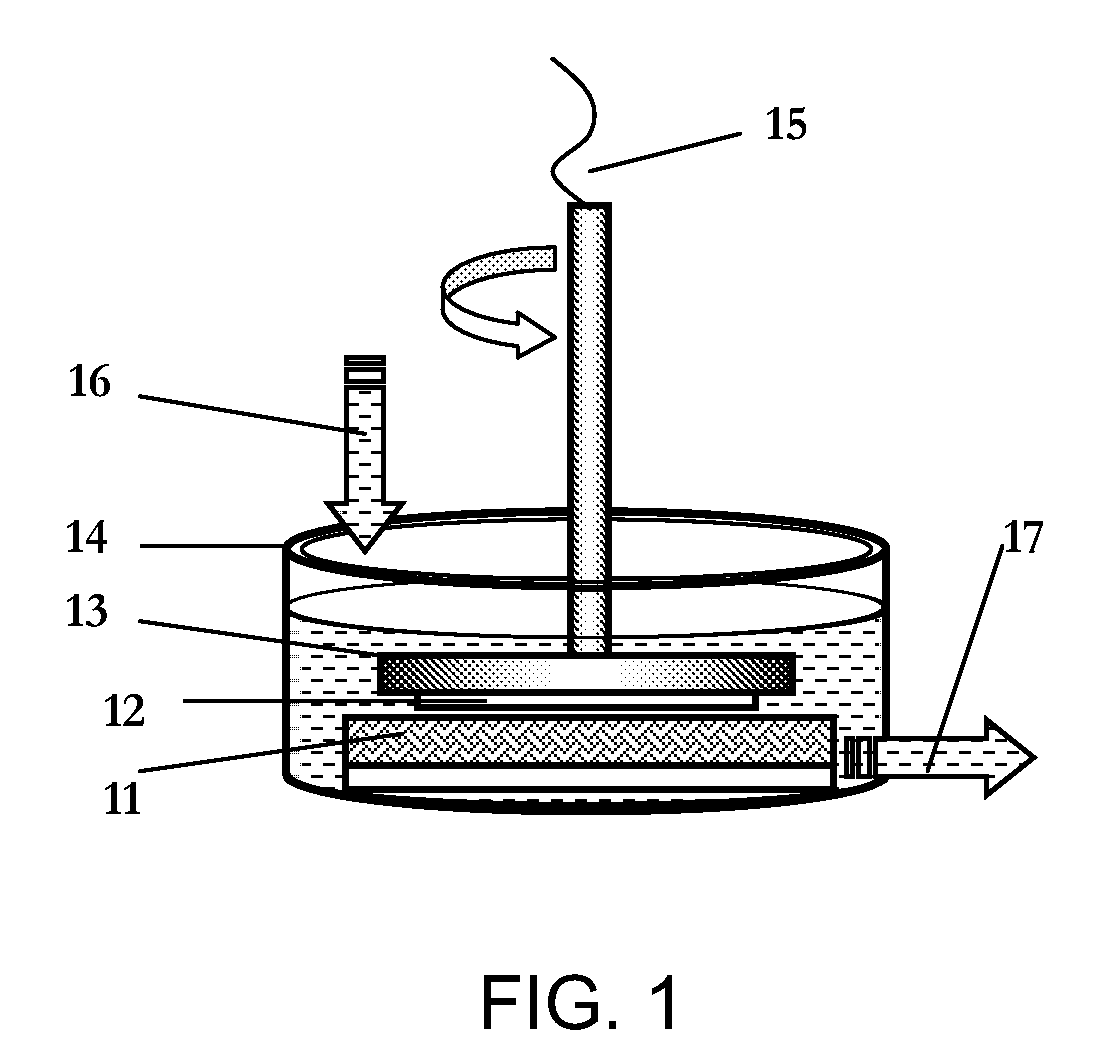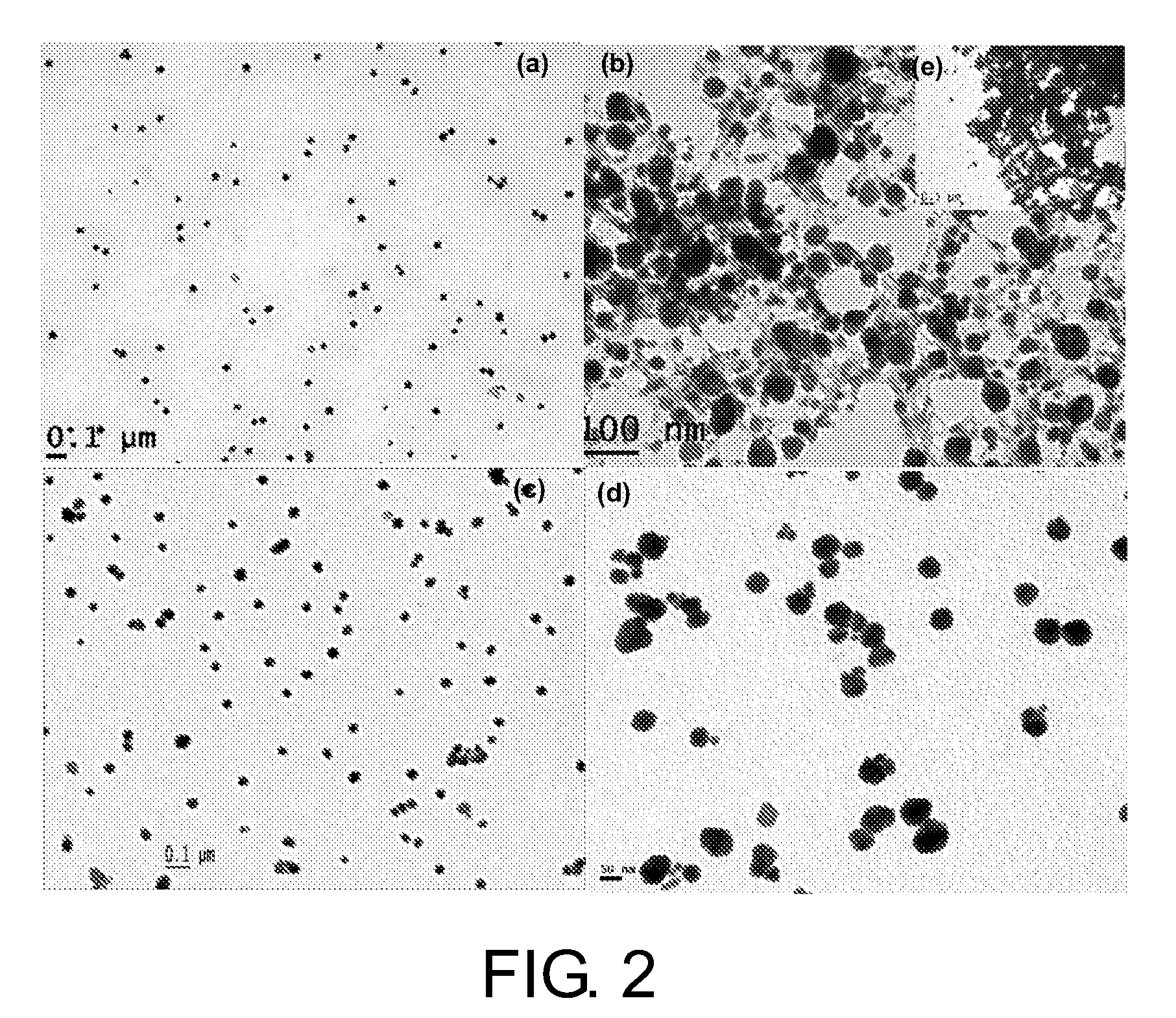Method for Making Nanoparticles
a nanoparticle and nanotechnology, applied in the field of nanoparticle making, can solve problems such as bulk formation and plating
- Summary
- Abstract
- Description
- Claims
- Application Information
AI Technical Summary
Benefits of technology
Problems solved by technology
Method used
Image
Examples
example 1
[0049]As an example of the synthesis strategy, silver nitrate (AgNO3, anhydrous, 99.9+%, Alfa Aesar) is mixed with polyvinylpyrrolidone (PVP, weight-average molecular weight of 58K, Acros Organics) in deionized water at room temperature at various reported concentrations. Nickel foil, iron foil, and cobalt foil (all 0.5 mm thick, 50×50 mm, Alfa Aesar) are employed as a heterogeneous reducing medium respectively for the generation of silver nanoparticles in the reactor. The molar ratio of AgNO3 / PVP (in repeating unit) is fixed at 1:1 for Ni and Fe reduction and 10 for Co reduction. The AgNO3 / PVP solution is put into the reaction vessel (150 ml in vessel) and an inlet reservoir. The volume of reaction solution remains constant at 150 ml during the whole procedure because of the balanced input and exit volumetric flow rate. The foil, immersed in the solution, rotates at high speed together with the substrate holder, and a hairy brush fastened to the vessel bottom remains in constant co...
example 2
[0051]In the typical synthesis, 100 ml solution of 0.0025 M HAuCl4.3H2O (Alfa Aesar, 99.99%) or 0.0025 M H2PtCl6.6H2O (Alfa Aesar, 99.9%), and 0.05 M (in repeating unit) Polyvinylpyrrolidone (PVP, K29-32, molecular weight=58000, Acros Organics) in distilled water was placed in a 600 ml uncovered beaker. The beaker was then put into an ultrasonic cleaner (Fisher Scientific, FS20H, continuous mode, 70 W output and 42 kHz, 2.8 L of tank volume and dimension (interior) D×W×H of 14×15.2×15.2 cm) tank with 400 ml tap water (beaker contacting bath bottom). The ultrasonication cleaner was turned on when the copper foil (1.0 mm thick, 50×50 mm, 99.99%, Alfa Aesar) or iron foil (0.5 mm thick, 50×50 mm, 99.99%, Alfa Aesar), was placed in the solution. The beaker was occasionally swirled by hand during the reaction while keeping the upper level of reaction solution below the water level of the bath. The whole process was performed at room temperature and in ambient condition. There was no obser...
example 3
[0052]A sample synthesis of the UAMDR is: 0.02 M of metal salt precursor, either copper (II) chloride dihydrate (CuCl2.2H2O, 99%, Acros Organics), iron (II) chloride (FeCl2, anhydrous, 99.5%, Alfa Aesar), cobalt (II) chloride hexahydrate (CoCl2.6H2O, 99.9%, Alfa Aesar), ruthenium (III) chloride hydrate (RuCl3.xH2O, 35-40% Ru, Acros Organics), or Tin (II) chloride (SnCl2, anhydrous,>99%, Alfa Aesar) or 0.01 M of silver nitrate (AgNO3, 99.9+%, Alfa Aesar) is mixed with polyvinylpyrrolidone (PVP, weight-average molecular weight of 58000, Acros Organics) in 100 ml deionized water or ethylene glycol (particularly for Sn nanoparticles preparation due to the hydrolysis of Sn2+ in water). The metal salt / PVP solution (molar ratio of 1 / 10, molar concentration of PVP is determined by the repeating unit) is put into a 500 ml beaker and then placed into the vessel of an ultrasonic cleaner (Fisher Scientific, FS20H, 70 W output and 42 kHz) with water. Cobalt foil (0.5 mm thick, 50×50 mm, 99.95%, ...
PUM
| Property | Measurement | Unit |
|---|---|---|
| Metallic bond | aaaaa | aaaaa |
| Electronegativity | aaaaa | aaaaa |
Abstract
Description
Claims
Application Information
 Login to View More
Login to View More - R&D
- Intellectual Property
- Life Sciences
- Materials
- Tech Scout
- Unparalleled Data Quality
- Higher Quality Content
- 60% Fewer Hallucinations
Browse by: Latest US Patents, China's latest patents, Technical Efficacy Thesaurus, Application Domain, Technology Topic, Popular Technical Reports.
© 2025 PatSnap. All rights reserved.Legal|Privacy policy|Modern Slavery Act Transparency Statement|Sitemap|About US| Contact US: help@patsnap.com



